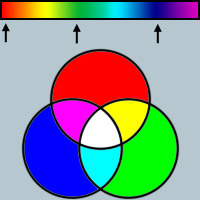 As you probably know... a given color of light can generally, be described by one number (e.g., the frequency of its wave length).
As you probably know... a given color of light can generally, be described by one number (e.g., the frequency of its wave length).
The color white, however, has no associated frequency; it is composed of equal amounts of all the (visible) frequencies of light. Black, of course, is the absence of light. And various shades of grey are generally composed of various intensities of white (as you lower the overall intensity of white, the grey gets darker and approaches black).
The question is: why is light (optically) additive? More specifically, why is it that when we add Red and Green together we get Yellow; Green and Blue together, we get Cyan; Red, Green, and Blue together, we get white?
(Please don't confuse this with the subtractive quality of pigments/paints, where as we add more colors, particularly more of the primary colors red, yellow, and blue, we approach black.)
Could we use three (or more) different colors and achieve the same result?



